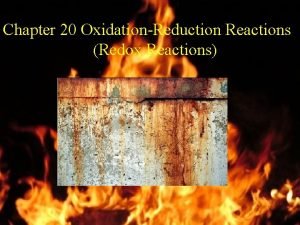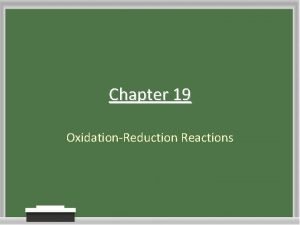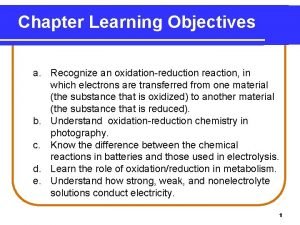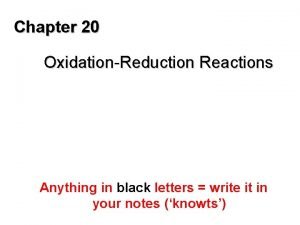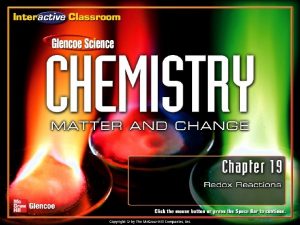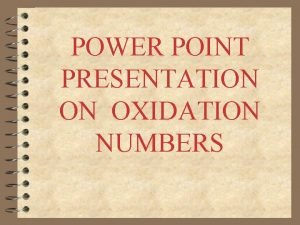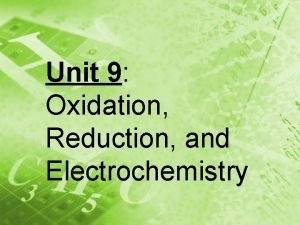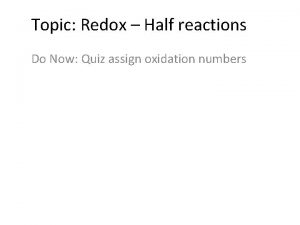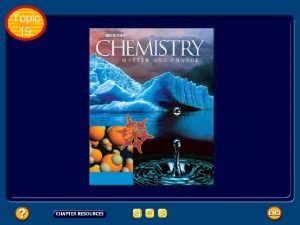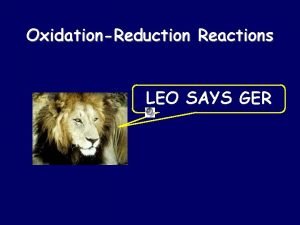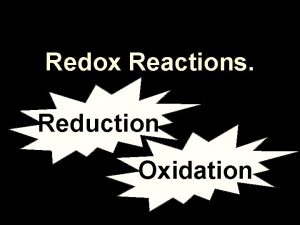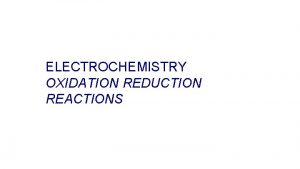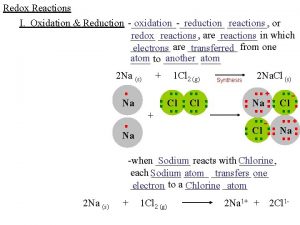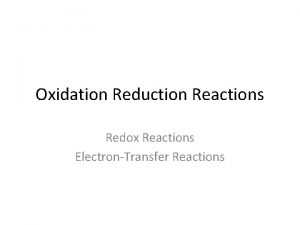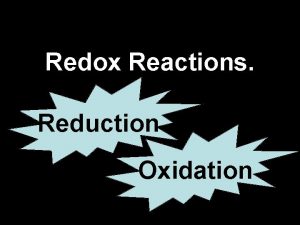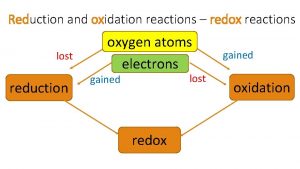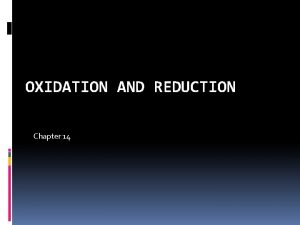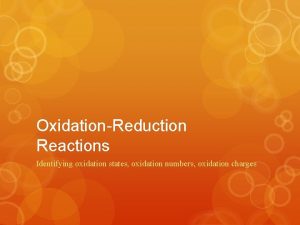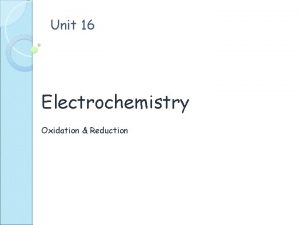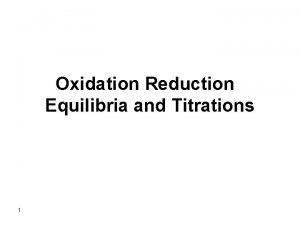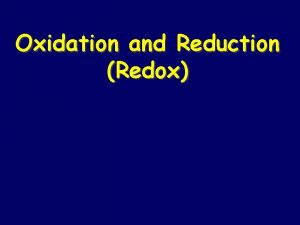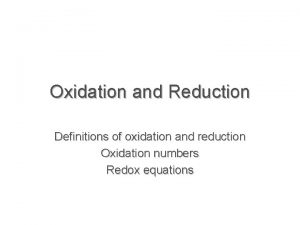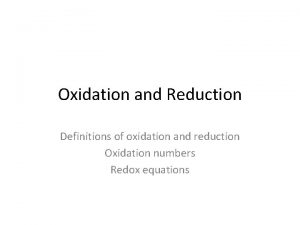Chapter 19 Oxidation Reduction Reactions 19 1 Oxidation

















- Slides: 17

Chapter 19 Oxidation - Reduction Reactions 19. 1 Oxidation and Reduction

Oxidation – Reduction • Rules for assigning oxidation numbers 1. Most substances have the same oxidation number as their individual charge (the more electronegative element 1 st) 2. All oxidation numbers in a compound must add up to equal the total charge on the compound 3. All single elements have a oxidation number of zero 4. All single ions have the same oxidation number as their charge 5. Oxygen has a charge of -2, except with F (+2), or peroxides (-1) 6. Hydrogen is usually +1, unless with a metal (-1)

Oxidation Half. Reaction Fe → Fe+2 + 2 e- • Reactions in which the atoms or ions of an element experience an increase in oxidation state • A species whose oxidation number increases is oxidized

Reduction Half. Reaction • Reactions in which the oxidation state of an element decreases. • A species that undergoes a decrease in oxidation Cu+2 + 2 e- → Cu state is reduced. Cu+2 + 2 e- → Cu + Overall Rxn Fe → Fe+2 + 2 e. Fe + Cu+2 → Fe+2 + Cu

Oxidation - Reduction +1 -1 0 0 +1 -1 Ag. Cl(aq) + Na(s) Ag(s) + Na. Cl(aq) Charge reduced from +1 to 0, so ewere gained The silver in silver chloride was reduced The sodium was oxidized OIL RIG Charge increased from 0 to +1, so e- were lost Oxidation is loss, reduction is gain

Leo the Lion goes Ger Lose Electrons Oxidation Gain Electrons Reduction Electron Loss Means Oxidation

Oxidation - Reduction +1 -2 0 0 H 2 O(l) H 2(g) + O 2(g) Charge reduced from +1 to 0, so ewere gained Charge increased from -2 to 0, so e- were lost The hydrogen in water was reduced The oxygen in water was oxidized

Example • Household Bleach removes stains through a redox reaction: Stain molecules (s) + OCl- (aq) → colorless molecules (s) + Cl- (aq) • Determine the oxidation numbers of oxygen & chlorine in OCl-2 +1

Chapter 19 Oxidation - Reduction Reactions 19. 2 Balancing Redox Equations

Example • Balance the following reaction: I- + Mn. O 4 - + H+ → Mn. O 2 + I 2 + H 2 O 2 I- + Mn. O 4 - + 4 H+ → Mn. O 2 + I 2 + 2 H 2 O But this reaction is balanced for mass not charge! A half-reaction system has to be used to balance for charge.

Half-Reaction Method 1. Write the formula equation then ionic equation 2. Assign oxidation numbers. Exclude anything with an ox. # of zero, or that doesn’t change ox. # 3. Write the ½ rxn for oxidation 4. Balance the atoms 5. Balance the charge (w/ electrons) 6. Write the ½ rxn for reduction 7. Balance the atoms 8. Balance the charge (w/ electrons) 9. Use coefficients to ensure the # of e- lost in ox. equals the # of e- gained in red. 10. Combine both ½ rxns and cancel (like Hess’s Law) 11. Combine ions to form initial compounds.

Example Now try to balance the following reaction: I- + Mn. O 4 - + H+ → Mn. O 2 + I 2 + H 2 O Half-Reactions: 2 Mn. O 4 - + 8 H+ + 6 e- → 2 Mn. O 2 + 4 H 2 O 6 I- → 3 I 2 + 6 e. Overall Balanced Equation: 6 KI + 2 KMn. O 4 + 8 HCl → 2 Mn. O 2 + 3 I 2 + 4 H 2 O + 8 KCl

Chapter 19 Oxidation - Reduction Reactions 19. 3 Oxidizing and Reducing Agents

Reducing Agent Fe + Cu+2 → Fe+2 + Cu Fe → Fe+2 + 2 e- • Substance that has the potential to cause another substance to be reduced. • They lose electrons; are oxidized. Iron causes Copper to become reduced, so it is the Reducing Agent

Oxidizing Agent Fe + Cu+2 → Fe+2 + Cu Cu+2 + 2 e- → Cu • Substance that has the potential to cause another substance to be oxidized. • They gain electrons; are reduced. Copper causes Iron to become oxidized, so it is the Oxidizing Agent

Disproportionation/ Autooxidation • A process by which a substance acts as both an oxidizing and reducing agent

 Chapter 19 redox reactions study guide answers
Chapter 19 redox reactions study guide answers Reducing agent strength table
Reducing agent strength table Chapter 19 review oxidation-reduction reactions answers
Chapter 19 review oxidation-reduction reactions answers Redox reaction
Redox reaction Redox reactions definition
Redox reactions definition Oxidation–reduction reactions
Oxidation–reduction reactions Leo the lion says ger
Leo the lion says ger What is redox reaction
What is redox reaction Explain oxidation
Explain oxidation Chemical reactions section 2 classifying chemical reactions
Chemical reactions section 2 classifying chemical reactions What are redox reactions examples
What are redox reactions examples Chemical reactions section 2 classifying chemical reactions
Chemical reactions section 2 classifying chemical reactions Chemical reactions section 3 reactions in aqueous solutions
Chemical reactions section 3 reactions in aqueous solutions Unit 5 chemical reactions answers
Unit 5 chemical reactions answers Which identifies an oxidation-reduction reaction?
Which identifies an oxidation-reduction reaction? Oxidation reduction quiz
Oxidation reduction quiz Which equation represents an oxidation-reduction reaction
Which equation represents an oxidation-reduction reaction Ger and leo
Ger and leo

